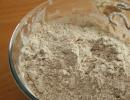Walnuts: composition, daily rate, benefits and harms. Walnut: composition, benefits, properties and calorie content. Walnut treatment
Walnuts are rich in substances, trace elements and vitamins, useful and necessary for the vital activity of the body. They contain: coratriterpenoids, steroids, alkaloids, vitamin C, tannins, quinones.
Walnut kernels contain a lot of magnesium, which has vasodilating and diuretic properties, as well as a lot of potassium, which can remove sodium from the body and increase urine output. All this explains the hypotensive properties of walnuts.
Ripe walnut fruits are an excellent multivitamin.
Beneficial features
The kernels of walnuts contain (in%): fat 45.5-77.0, nitrogenous substances 8.7-18.9, water 3.3-5.7, nitrogen-free substances 7.9-19.4, fiber 2 , 5-7.6, ash substances 1.4-2.3. Nuts are rich in vitamins, especially vitamin C, less in vitamins A and B. Unripe nuts are extremely rich in vitamin C - from 1000 to 3000 mg per 100 g. 
According to nutritionists, walnuts are an extremely valuable food product, which contains a lot of useful substances. Nut fat is especially useful for the body: it is very rich in unsaturated fatty acids - linoleic, linolenic and oleic. Recently, experts have established the great importance of these acids for the prevention of atherosclerosis.
By the content of protein substancesWalnuts come close to meat, fish and some dairy products. There are a lot of essential amino acids in them, and the content of walnut protein is in one of the first places among plant products. Nuts are low in carbohydrates, which means they are good for those with diabetes as well. Nuts contain a lot of mineral salts - potassium, calcium, phosphorus and iron, as well as trace elements that are part of various enzymes that affect metabolic processes and are involved in hematopoiesis.
In terms of iodine and zinc content, nuts are superior to many other plant foods. It is no coincidence that walnuts are useful for everyone - for children and adults, healthy and sick. Doctors recommend using nuts in combination with honey during the recovery period after serious illnesses, together with fruits and honey - for the treatment of anemia, with poor weight gain in children, with a lack of breast milk in nursing mothers.
Walnut in cooking
Inhabitants of the Caucasus and Central Asia use walnuts in their natural form and for cooking, they are added to sauces, they are used to season some types of game, cakes, cookies and cakes are prepared with them. In the Caucasus in the summer, everywhere on the terraces of rural houses hung in the sun "nut sausages" - one of the most favorite delicacies of the southerners - "Churchkhela".
Storing nuts
Walnut shells are hard, woody, but at the same time hygroscopic: through very small pores, the shell passes oxygen from the air, under the influence of which the kernel dries out and oxidative processes such as salting and rancidity of fatty oils. That is why, after long-term storage, the walnut kernel deteriorates (goes rancid).
Walnuts are stored for no more than a year in a dry, odorless place at temperatures from -15 to +20 ° C (without sudden fluctuations). Before use, the nuts are peeled from the shell, the partitions are removed and the kernel is taken out. In this case, the nuts are much easier to peel if you hold them for 10-15 minutes in a hot oven. And the kernels of the nuts after that will become tastier.
Also called the king's nut, it is a powerful tree with a thick trunk and a spreading crown, reaching a height of 35 meters. In the wild, the walnut tree grows in Asia Minor and Central, in the Caucasus and in the countries of the Balkan Peninsula. It is also cultivated as a fruit tree in China, the USA and in the southern part of Russia. The fruit of a walnut is a so-called fake drupe (bone), that is, in structure it is similar to a peach, plum or apricot, in which the bone is covered with a thick and juicy shell. On the tree, the walnut fruit also ripens in a soft shell, getting rid of it when ripe.
The composition and calorie content of walnuts
Feature walnut is that its chemical composition changes depending on the degree of maturity of the fruit, while in dried form it retains all its beneficial features... It is characterized by the presence of fats in the range of 45-77%, proteins 8-21%, carbohydrates up to 10% and water up to 5%. Its calorie content is 648 kcal per 100 grams of product. In cores walnut found free amino acids (asparagine, valine, glutamine, histidine, serine, phenylalanine and cystine), provitamin A, vitamins E, PP, K, group B, as well as minerals and trace elements (iodine, calcium, potassium, cobalt, magnesium, iron , zinc, phosphorus). As for vitamin C, which is part of a walnut, according to scientific research, it is found in large quantities only in unripe fruits, while its content is minimized when ripe.
Walnut: benefits and properties
As mentioned above, the kernel of a walnut can be 77% fat, but most of these are unsaturated fats, which practically do not contain cholesterol. Nutritionists recommend eating a few nuts a couple of hours after playing sports to satisfy hunger, restore the body's energy supply, strengthen muscles and relieve fatigue, without the risk of gaining extra pounds.
Due to its rich iodine content, walnuts are included in the diet of people with thyroid diseases, and are also advised to be consumed by those who live in an unfavorable radiation fund.
Walnut helps with nervous disorders, heart and colds... It strengthens the liver, normalizes gastric secretion, relieves worms. Its property is also known to decrease blood pressure and promote the cure of anemia.
Walnut kernels are also used as a general tonic., useful for recuperation after serious illness, injury, surgery and childbirth. It improves the state of the immune system and is necessary for older people, pregnant women and nursing mothers. Regular use is also believed to improve memory.
The recommended serving of walnuts is no more than 5 kernels daily... This will be enough to saturate the body with useful trace elements, vitamins and can be considered a kind of prevention of the diseases already described above.
Walnut treatment: recipes

When treating a walnut, not only its kernels (both mature and young) are used, but also internal partitions, peel and even leaves, which, in terms of the presence of carotene and vitamin C in them, are not inferior to the wild rose, which is so popular among the people.
For the prevention of atherosclerosis: 10 walnut kernels, two slices, one tablespoon of vegetable oil. Chop nuts and garlic, mix with oil. Eat as a salad dressing or spread on bread.
To strengthen the heart muscle: a mixture of nuts and raisins. Include in the diet at least once a week.
To enhance immunity: walnuts,. Can be scrolled in a meat grinder or chopped in a blender to obtain a homogeneous mass. An excellent substitute for dessert or an addition to your evening tea.
If you are buying whole walnuts, do not throw away the inner partitions when peeling them. An infusion of them improves the hormonal fund and strengthens immune system... Ingredients: medical alcohol 100 gr., Partitions of 25 nuts. Insist for 10 days, then use 20 drops three times a day.
As for the peel of a walnut (from an unripe fruit), since ancient times it has been used to treat various skin diseases - eczema, dermatitis, ringworm, herpes. Baths with a decoction of dry walnut leaves are also used to combat eczema and lichen. The composition of the broth: 1 liter of water, 300 gr. leaves. Boil for 20 minutes, leave for 4 hours, then strain and add the concentrate to a bath of warm water.
With a decoction of the leaves, in addition, they caress the throat and cavity in case of inflammation, to eliminate their bleeding, or simply take it orally (1 tablespoon each) as a vitamin preparation. It is recommended even for diabetics, since walnut leaves have a hypoglycemic effect. It also has a mild diuretic effect and is useful for diseases of the urinary system, including urolithiasis.

Unripe walnuts act primarily as an ingredient for making jam. It is a rather complicated and time-consuming process, but the result is said to be worth it.
Young nuts (at the stage of their milky ripeness) can also be infused. Ingredients: alcohol (70 °) 1 liter, walnuts 30 pcs. Insist at room temperature, without access to light for 15 days, and then filter. The infusion is taken for peptic ulcers, diarrhea in the amount of 1 teaspoon three times a day.
An interesting fact is that in European countries walnuts (kernel, shell, septa and leaves) are used in official medicine and pharmacology. With their help, fortifying, vasodilating, anti-inflammatory, choleretic, diuretic and anthelmintic drugs are made. While in our country, in the presence of positive results of various scientific research, the use of walnuts is limited only to recipes of traditional medicine.
Walnutrich in vitamins and minerals such as: dietary fiber - 30.5%, vitamin B1 - 26%, vitamin B5 - 16.4%, vitamin B6 - 40%, vitamin B9 - 19.3%, vitamin E - 17.3 %, vitamin PP - 24%, potassium - 19%, magnesium - 30%, phosphorus - 41.5%, iron - 11.1%, cobalt - 73%, manganese - 95%, copper - 53%, fluorine - 17 , 1%, zinc - 21.4%
What is useful Walnut
- Vitamin B1 is a part of the most important enzymes of carbohydrate and energy metabolism, which provide the body with energy and plastic substances, as well as the metabolism of branched-chain amino acids. Lack of this vitamin leads to serious disorders of the nervous, digestive and cardiovascular systems.
- Vitamin B5 participates in protein, fat, carbohydrate metabolism, cholesterol metabolism, the synthesis of a number of hormones, hemoglobin, promotes the absorption of amino acids and sugars in the intestine, supports the function of the adrenal cortex. Lack of pantothenic acid can lead to damage to the skin and mucous membranes.
- Vitamin B6 participates in maintaining the immune response, inhibition and excitation processes in the central nervous system, in the conversion of amino acids, the metabolism of tryptophan, lipids and nucleic acids, contributes to the normal formation of red blood cells, maintenance of normal levels of homocysteine \u200b\u200bin the blood. Insufficient intake of vitamin B6 is accompanied by a decrease in appetite, a violation of the condition of the skin, the development of homocysteinemia, anemia.
- Vitamin B9 as a coenzyme, they participate in the metabolism of nucleic acids and amino acids. Folate deficiency leads to impaired synthesis of nucleic acids and protein, which results in inhibition of cell growth and division, especially in rapidly proliferating tissues: bone marrow, intestinal epithelium, etc. Insufficient consumption of folate during pregnancy is one of the causes of prematurity, malnutrition, congenital malformations and developmental disorders of the child. There has been a strong association between folate and homocysteine \u200b\u200blevels and the risk of cardiovascular disease.
- Vitamin E possesses antioxidant properties, is necessary for the functioning of the gonads, heart muscle, is a universal stabilizer of cell membranes. With a deficiency of vitamin E, hemolysis of erythrocytes and neurological disorders are observed.
- Vitamin PP participates in redox reactions of energy metabolism. Insufficient vitamin intake is accompanied by a violation of the normal state of the skin, gastrointestinal tract and nervous system.
- Potassium is the main intracellular ion that takes part in the regulation of water, acid and electrolyte balance, participates in the processes of conducting nerve impulses, pressure regulation.
- Magnesium participates in energy metabolism, synthesis of proteins, nucleic acids, has a stabilizing effect on membranes, is necessary to maintain homeostasis of calcium, potassium and sodium. A lack of magnesium leads to hypomagnesemia, an increased risk of developing hypertension, heart disease.
- Phosphorus takes part in many physiological processes, including energy metabolism, regulates acid-base balance, is a part of phospholipids, nucleotides and nucleic acids, is necessary for the mineralization of bones and teeth. Deficiency leads to anorexia, anemia, rickets.
- Iron is a part of proteins of various functions, including enzymes. Participates in the transport of electrons, oxygen, ensures the course of redox reactions and activation of peroxidation. Insufficient consumption leads to hypochromic anemia, myoglobin-deficient atony of skeletal muscles, increased fatigue, myocardiopathy, atrophic gastritis.
- Cobalt is part of vitamin B12. Activates enzymes of fatty acid metabolism and folic acid metabolism.
- Manganese participates in the formation of bone and connective tissue, is part of the enzymes involved in the metabolism of amino acids, carbohydrates, catecholamines; essential for the synthesis of cholesterol and nucleotides. Insufficient consumption is accompanied by a slowdown in growth, disorders in the reproductive system, increased fragility of bone tissue, disorders of carbohydrate and lipid metabolism.
- Copper is a part of enzymes with redox activity and involved in iron metabolism, stimulates the absorption of proteins and carbohydrates. Participates in the processes of providing the tissues of the human body with oxygen. The deficiency is manifested by disorders in the formation of the cardiovascular system and skeleton, the development of connective tissue dysplasia.
- Fluorine initiates bone mineralization. Insufficient consumption leads to tooth decay, premature erasure of tooth enamel.
- Zinc is a part of more than 300 enzymes, is involved in the synthesis and decomposition of carbohydrates, proteins, fats, nucleic acids and in the regulation of the expression of a number of genes. Insufficient intake leads to anemia, secondary immunodeficiency, liver cirrhosis, sexual dysfunction, and fetal malformations. Research recent years revealed the ability of high doses of zinc to disrupt the absorption of copper and thereby contribute to the development of anemia.
Complete reference most useful products you can see in the app
Natural product with high nutritional value. The components included in their composition help to control weight and build up muscles, treat many diseases, and maintain the body's energy reserves. Despite the benefits of the product, it is contraindicated for some people, so you need to use it with caution, avoiding overeating.
Walnuts composition
The walnut kernels contain a complex of useful vitamins and minerals that the body needs:
- b vitamins;
- vitamins A, E, K;
- vitamin C;
- potassium;
- phosphorus;
- magnesium;
- calcium;
- copper;
- zinc;
- selenium;
- sodium;
- manganese.
Eating 100 g of the product, you can get 36% of the daily value of vitamin B6, which prevents aging, 29% of thiamine, which plays one of the main roles in all metabolic processes and promotes muscle development.
Not only the kernels, but also the rest of the walnut are endowed with a useful composition. Its leaves and pericarp are rich in tannins, vitamins C, E, alkaloids and carotene. The shell contains coumarins and steroids, phenol carboxylic acids and pellicle. A large number of vitamins and carotene are even in unripe nuts.
Walnut
Video: Walnut - benefits and harms... The composition and calorie content of walnuts
The energy value
Walnuts are high in calories. 100 g contains:
- 654 Kcal;
- 16.2 g of proteins;
- 60.8 g of fat;
- 11.1 g of carbohydrates;
- 6.1 g of dietary fiber;
- 3.8 g of water.
Just one quarter of a cup of walnuts contains the daily requirement of omega-3 polyunsaturated fats. They support the health of the heart, brain and blood vessels.
Beneficial features
The benefits of walnuts in nutrition were discovered by traditional healers in ancient times. Avicenna created various drugs on their basis to stop bleeding, and oriental doctors - to strengthen the heart, liver and even the treatment of tuberculosis. Nowadays, different parts of walnuts are included in the composition of fortifying, antihelminthic and disinfecting agents used in official medicine. Healers still use the leaves of the plant to stop bleeding.
Fresh nuts are also beneficial to the body. They are constantly eaten by the inhabitants of the Caucasus, who are famous for their excellent health and longevity. They are sure that it is thanks to the walnut that they do not have vision problems.
Improving mental performance
Many have noticed that the shape of the walnut kernel resembles the hemispheres of the brain. This is not a coincidence. The plant stimulates the synthesis of about 40 neurotransmitters - biologically active substances that support brain activity. Walnuts also fight mental fatigue, so it is recommended to include them in the diet of intellectual workers.
Normalization of the functions of the heart and blood vessels
Although walnuts consist of fats by 65%, due to the Omega-3 complex and minerals, they lower blood cholesterol levels. This product is included in therapeutic diets for arterial hypertension, atherosclerosis and other cardiovascular diseases.
Walnuts contain gamma, not the more common alpha-tocopherol. This form of vitamin E is healthier for the body and protects the heart. The product maintains an optimal chemical composition of the blood, contains antioxidants and anti-inflammatory substances, improves the elasticity of the vascular walls, preventing their damage.
Prevention and treatment of diabetes mellitus
Doctors recommend their patients eat walnuts for prevention and treatment diabetes mellitus Type II. This product helps control the levels of insulin and sugar involved in metabolism. The main benefit of walnuts for diabetics is to reduce the risk of heart and vascular problems.
Oncology prevention
The unique chemical composition of walnuts makes them important element most people's diet. The only exceptions are those for whom the product is contraindicated. The antioxidants contained in nuts minimize the risk of developing breast, prostate and other cancers. A number of properties of the product help to reduce inflammatory processes, under the influence of which healthy cells mutate into malignant ones. Walnuts prevent the development of the oxidative process, and when it appears, they prevent it from becoming chronic.
Walnuts in sports and dietary nutrition
Despite the high calorie content of walnuts, their regular consumption helps to reduce body weight. This is the conclusion reached by scientists at the University of Louisiana in the United States. They conducted a study in which two groups of people participated: those who like walnuts and those who do not eat them at all. The researchers wanted to find out how strongly a product affects weight.
It found that people who regularly eat walnuts are generally slimmer than those who ditch them entirely. Scientists explain that anti-inflammatory components contained in the nuclei of the plant provide reliable prevention of obesity.
Proteins, vitamins, trace elements and polyunsaturated fatty acids convert walnuts into an essential element healthy eating... For people who play sports, they help relieve physical fatigue due to essential oils and fiber. The high protein content accelerates muscle gain.
Benefits for men
It is scientifically proven that walnuts enrich the male body with zinc, magnesium and calcium, and also improve the synthesis of the sex hormone, which ensures normal potency. Green nuts are especially beneficial. They are rich in vitamins E and P, which have a positive effect on male sexual function. For these purposes, nuts are best eaten with dried fruits or honey.
Due to its antioxidant properties, walnuts prevent the risk of developing prostate adenoma. It is hypothesized that they stimulate sperm production, which increases the chances of conception.
Benefits for women
Walnuts bring invaluable benefits to women, especially those who are planning a pregnancy. They have a positive effect on the condition of the fetus, providing it with important trace elements and vitamins for growth and development. If mom continues to eat walnuts after giving birth, her milk becomes fatter and sweeter. As a result, the baby begins to suckle better and gain weight faster.
Daily rate and rules of use
To maintain health, longevity and a beautiful figure, it is recommended to eat 7 walnuts every day. To digest them well, they must be chewed thoroughly.
Strengthening the body with walnuts
It is useful to use such a composition: mix one glass of chopped walnuts, raisins and dried apricots, add one lemon rolled through a meat grinder and 300 g of honey. This delicacy should be eaten 1 tablespoon 3 times a day before meals. It has a tonic effect, strengthens the immune system and energizes.
- 6 nucleoli - in the morning half an hour before breakfast;
- 5 - before lunch;
- 4 - before dinner.
According to this scheme, people were treated many centuries ago. The recipe does not lose its relevance today, which confirms its effectiveness.
To whom and in what cases do walnuts harm?
While walnuts protect against various diseases for most people, they can harm some. It should not be consumed by those who suffer:
- Allergies to nuts and / or protein - there is a risk of developing anaphylactic shock.
- Eczema, psoriasis, neurodermatitis - even a couple of nuts can exacerbate ailments.
- Severe bowel disorders - a possible complication in the form of colitis.
- Obese - walnuts help control weight, but if the body weight is too high, they are contraindicated due to the high calorie content.
- stomatitis (a rash on the mucous membrane in the mouth);
- inflamed glands;
- spasms of cerebral vessels;
- diathesis.
Do not eat moldy or darkened walnuts. These signs indicate that the production of a toxic enzyme has begun, which is a serious health threat.
Walnut - durable tall tree, distinguished by its thick trunk and sweeping crown. The people call this powerful tree the king's nut. And it's not easy, because the age of trees can reach 600 years. After 10 years of life, the tree begins to yield. The walnut fruit is similar to the texture of a plum tree or apricot. A soft, juicy shell covers the bone. Once ripe, the walnut gets rid of it by splitting. Most often, the tree brings a large harvest, which can reach 300 kg per tree. Nut ripening occurs in mid-autumn - October. It is at this time that you can get enough of a valuable storehouse of health.
Nutritional value of the product
Nutritional value of 100 g:
- Caloric value: 656 kcal
- Protein: 16.2 g
- Fat: 60.8 gr
- Carbohydrates: 11.1 g
- Dietary Fiber: 6.1g
- Water: 3.8 gr
- Saturated Fatty Acids: 6.2 g
- Mono- and disaccharides: 3.9 g
- Starch: 7.2 gr
- Ash: 2 gr
Macronutrients:
- Calcium: 89 mg
- Magnesium: 120 mg
- Sodium: 7 mg
- Potassium: 474 mg
- Phosphorus: 332 mg
- Chlorine: 25 mg
- Sulfur: 100 mg
Vitamins:
- Vitamin PP: 1.2 mg
- Beta-carotene: 0.05 mg
- Vitamin A (RE): 8 mcg
- Vitamin B1 (thiamine): 0.39 mg
- Vitamin B2 (riboflavin): 0.12 mg
- Vitamin B5 (pantothenic) 0.8 mg
- Vitamin B6 (pyridoxine): 0.8 mg
- Vitamin B9 (folate): 77 mcg
- Vitamin C: 5.8 mg
- Vitamin E (TE): 2.6 mg
- Vitamin K (phylloquinone) 2.7 μg
- Vitamin PP (Niacin Equivalent): 4.8 mg
Trace elements:
- Iron: 2 mg
- Zinc: 2.57 mg
- Iodine: 3.1 mcg
- Copper: 527 mcg
- Manganese: 1.9 mg
- Selenium: 4.9 mcg
- Fluoride: 685 mcg
- Cobalt: 7.3 mcg
A distinctive feature of the walnut is that its composition varies with the level of ripeness of the fruit. But this does not mean that in dry form it loses all its properties, on the contrary, dried nut reaches a maximum fullness of vitamins and minerals.
 In spring, the nut will save you with vitamin deficiency, iron deficiency. The content of potassium and magnesium in the nut has a prophylactic effect in case of anemia, diseases of the cardiovascular system. Mandatory use of walnuts for diseases of the gastrointestinal tract, kidneys, liver. The presence of vitamins A, E improves the activity and permeability of blood vessels, and triggers the disappearance of sclerotic plaques.
In spring, the nut will save you with vitamin deficiency, iron deficiency. The content of potassium and magnesium in the nut has a prophylactic effect in case of anemia, diseases of the cardiovascular system. Mandatory use of walnuts for diseases of the gastrointestinal tract, kidneys, liver. The presence of vitamins A, E improves the activity and permeability of blood vessels, and triggers the disappearance of sclerotic plaques.
Walnut is an indispensable tool for men. By adding a handful of nuts to your diet every day, you can quickly restore sexual function. It is advisable to mix with honey and dried fruits. In the shortest possible time, the nut will help cure the adenoma.
Various infusions are prepared from the fruit of the walnut. For example, for effective treatment mastopathy, tumors, an infusion of walnut shell partitions will help. Also acts as a sedative against psychological stress. By preparing a tincture from leaves and partitions, you can lower the concentration level, so experts insist on using walnuts for the treatment of diabetes.

The nut is also useful for diseases of the gastrointestinal tract. With regular use, intestinal function normalizes, the level of gastric secretion also returns to normal.
Important! Baths based on a decoction of walnut leaves are useful for young children. It will especially help babies with scrofulous disease or rickets.
Walnut fruits are an irreplaceable cosmetic product. Many face masks are prepared based on it. It contains vitamin F, which improves the activity of the skin. Removes excess oiliness of the skin without drying it out, deeply cleanses, closes open pores and tones up.
Walnut is useful for hair. Washing the head with a strong decoction of walnut leaves will help to normalize the sebum secretion of the scalp. Restores the structure of each hair, cleanses, normalizes blood circulation in the hair follicles. However, rinsing your head with such a decoction is recommended exclusively for brunettes, since after washing the hair becomes a darker shade.
Despite the richest content of vitamins and microelements, walnuts can be dangerous for people suffering from chronic colitis and enterocolitis. In no case should you eat a nut if you have increased blood clotting or an acute intestinal disease.
Eating walnuts in large quantities can lead to allergies, and lead to corresponding reactions - rash, redness, urticaria, diathesis, allergic stomatitis. Overeating also causes all kinds of irritation of the oral cavity, inflammation of the tonsils. The nut is high in calories, which is also not very healthy.

The walnut can cause serious harm to people who are sick with various skin diseases - neurodermatitis, psoriasis, eczema and others. Even minimal consumption of walnuts will exacerbate the disease.
If you decide to eat walnuts, never buy them already peeled! You will never know where they were cleaned, place and shelf life. It is better to clean yourself and do not doubt their usefulness and the presence of microbes.
Do not buy nuts in kilograms, because you never know what awaits you inside, under the shell. First, buy a handful of nuts, break the shell. Evaluate the quality of the walnut itself, its shells and partitions. Only after that, feel free to buy the required amount.






